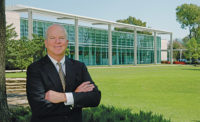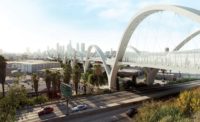Spanning 1.1 million gross sq ft, the $1.8-billion Intuit Dome is the latest in a long series of sports arenas to rise along the West Coast. Its iconic structural steel exterior creates an easily identifiable landmark in Inglewood, Calif., while its carbon-free footprint and fan-focused amenities create a sustainable entertainment venue.
When L.A. Clippers owner Steve Ballmer envisioned the team playing in its own home, he sought guidance from AECOM. That early collaboration led to the firm’s installment as lead designer, recalls Bill Hanway, the firm’s global sports leader.
After initial site selection and concept design, Ballmer then brought AECOM Hunt on board to review real-time construction cost estimates. A separate procurement led to the hire of an AECOM Hunt and Turner Construction joint venture as construction manager at-risk.

Features at Intuit Dome include the largest-ever double-sided halo display in an arena setting, which spans 38,375 sq ft and will include 233 million LEDs.
Photo courtesy of the Los Angeles Clippers
That delivery method “allowed for an extended preconstruction period during design development, which was critical given the incredible amount of preplanning and coordination required to deliver a world class arena,” says Reed McMains, vice president and general manager at Turner Construction.
An intense early focus on the owner’s commitment to the community was another important aspect of the RFP response, he adds. More than 7,000 jobs will be created during the nearly three-year construction process that kicked off in September 2021. The team also set 30% MDBE participation and high local hire goals, says joint venture project executive Rames Sundaram.
“The project has employed over 1,000 residents from Inglewood and the surrounding communities, which amounts to over 640,000 hours worked to date,” McMains adds.
Upon completion, about 30% of permanent jobs will go to local residents, and the stadium will help generate approximately $260 million in annual economic activity.

The arena is fully electric, with 2 MW of rooftop solar panels that feed into 11 MW of battery storage.
Photo courtesy of the Los Angeles Clippers
Experience-focused
Intuit Dome features three components: the 17,700-seat arena itself with five basketball courts—more than any other NBA arena—along with more than 86,000 sq ft of training, medical and player spaces. The final piece, located above the practice courts, is a 71,000-sq-ft office building for team operations, supported by multiple 145-ft floor trusses.
Elements that help create an intimate live event experience include The Wall—51 uninterrupted rows of seats for 4,500 fans to sit adjacent to the visiting team’s bench.
“The project has employed over 1,000 residents from Inglewood and the surrounding communities.”
—Reed McMains, Vice President and General Manager, Turner Construction
Creating a bowl that includes the best legroom and sight lines in the NBA took ample research as well. “We started the process by visiting a number of venues with Steve [Ballmer] when they were both empty and during events. This interactive process continued throughout the project,” Hanway adds. Every seat at Intuit Dome is 20 in. wide and every row is 35 in. deep.
Meanwhile, The Halo scoreboard is attached to the underside of the main trusses. This puts the 27-ft-high, continuous wrap-around 4K LED screens at eye level for the upper bowl seats. The double-sided halo display spans 38,375 sq ft and will be equipped with more than 233 million LEDs upon completion.
With the arena’s design and ambitious technology goals, the team coordinated with technology partners early in preconstruction to ensure space, power and raceway requirements were included early in both design and construction sequencing, Sundaram says.
Instead of a traditional central utility plant, Intuit Dome has a modular central utility plant that was built off site, saving on both time and cost, adds Craig Bojda, a project executive with the joint venture.

Crews placed more than 73,000 cu yd of concrete throughout Intuit Dome. The arena's largest foundation placement required 2,572 cu yd of concrete, while the largest deck placement called for 980 cu yd.
Photo courtesy of the Los Angeles Clippers
Structured Inside and Out
Supporting the arena’s 2,784-ton roof are seven primary trusses, each weighing about 120 tons. But to put those in place, the team had to consider both the arena’s proximity to the airport and the tight site, Bojda says.
Instead of bringing in larger cranes, steel erection took place from within the bowl using two Liebherr LR-1300 lattice boom crawler cranes. Their movement had to be carefully choreographed on a daily basis to safely lift those trusses into place, Bojda adds.
On the stadium’s exterior is an iconic 2,791-ton diagrid structural steel frame, its design inspired by a basketball net. It consists primarily of pipe radial, diagonal members and complex nodes, he explains. “The diagrid does not land on a foundation structure and is essentially hung from the primary arena structural frame, generally at four points of connection per radial,” Bojda says.
That frame is then clad by a series of 228,700 sq ft of PTFE and 11,400 sq ft of ETFE panels. The PTFE panels clad a secondary 871-ton structural steel frame, which actually connects to the diagrid.
Over the upper concourse level, the PTFE panels enclose the building, but along the more vertical portions of the frame, they act as a perforated rain screen, Bojda says. This system also protects the building from direct sun exposure, helping to reduce cooling and energy requirements.
“The use of PTFE and EFTE exterior cladding systems, while not unique to the sports building type, is unique for an arena.”
—Craig Bojda, Project Executive, AECOM Hunt Turner Joint Venture
But limited space and access between the diagrid frame and the metal panel and curtain wall systems “posed logistical challenges from a sequencing perspective,” Bojda says. So, the building enclosure system had to be installed before erecting the diagrid structure. “The use of PTFE and EFTE exterior cladding systems, while not unique to the sports building type, is unique for an arena,” he says.
Given the arena’s location less than a mile from the Newport-Inglewood Fault, the diagrid shell required particular attention “regarding its seismic behavior and its interaction with the primary superstructure,” explains Ryan Anderson, principal at Walter P Moore, the project’s structural engineer. Since the shell serves as a roof and facade component, “it was essential to securely attach it to the primary structure while allowing for significant movement during an earthquake,” he says.
To do that, Walter P Moore developed a toggle brace connection for the shell at Levels 4 and 7, which “supports the shell out of a plane by the primary structure while permitting free rotations in both vertical and translational directions,” Anderson says. “The toggle brace detailing ensures that the diagrid shell can work harmoniously with the arena structure, minimizing the accumulation of seismic forces.” It also ensures that the primary superstructure’s lateral system, comprised of buckling restrained braces, continues to perform its intended function and maintain the correct seismic load path, he adds.
Other innovations came in materials, such as the addition of a carbon-absorbing additive into the floor slab concrete. The team even worked with manufacturers to develop prototypes of several undisclosed one-of-a-kind technology components. Meanwhile, Microsoft HoloLens technology allowed crews to use real-time BIM information in augmented reality to verify work in place and resolve conflicts. “As far as we know, we are the first construction company to retrofit a hardhat to accommodate the lens technology to use in the field,” Bojda adds.

PTFE panels enclose the building over the upper concourse level. The panels also protect from direct sunlight and serve as perforated rain screens over vertical portions of the frame.
Photo courtesy of the Los Angeles Clippers
Sustainable Charge
In addition to achieving LEED Platinum certification, Intuit Dome will be 100% carbon free from the day it opens to the public. That’s in part thanks to the structure being fully electric, equipped with 2 MW of rooftop solar panels that feed 11 MW of battery storage.
“This provides two benefits,” Hanway says. “The first is that we can run an NBA game or concert in full operation directly from the batteries. The second is that the battery capacity allows us to moderate the draw from the grid so that we don’t add to capacity issues during peak usage.”
Intuit Dome also features a comprehensive waste reduction program that eliminates landfill waste, and in a first for a large-scale venue, the stadium is also committed to monitoring annual greenhouse gas emissions and transportation impacts.
“The pandemic also made us think about the design itself,” Hanway says. “How might a stadium cope with the pandemic and support healthy environments? This question led us to incorporate key features to mitigate future pandemics, including providing fans with 100% outside air” with a natural ventilation system.
With these features and more, hopes are that Intuit Dome will raise the bar for sporting venues, with intensive focus on sustainability through design and fan experience.
As of September 2023, crews are set to surpass 3 million trade hours, while construction is 70% complete and on track for summer 2024 completion.




Post a comment to this article
Report Abusive Comment